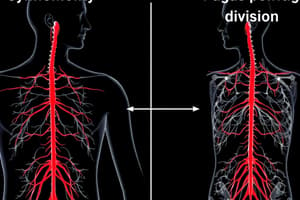Podcast
Questions and Answers
What effect does sympathetic stimulation have on pupil response?
What effect does sympathetic stimulation have on pupil response?
- Pupils become fixed and dilated regardless of conditions.
- Pupil constriction occurs for increased light intake.
- There is no effect on the pupils.
- Pupillary dilation allows more light in. (correct)
Which receptor type is primarily responsible for increasing heart rate during sympathetic stimulation?
Which receptor type is primarily responsible for increasing heart rate during sympathetic stimulation?
- Muscarinic receptors
- β1 Receptors (correct)
- α-Receptors
- β2 Receptors
Which of the following accurately describes the effect of muscarinic agonists like Pilocarpine?
Which of the following accurately describes the effect of muscarinic agonists like Pilocarpine?
- Promote parasympathetic effects by increasing salivation. (correct)
- Inhibit bladder contraction and promote filling.
- Increase heart rate and promote vasoconstriction.
- Mimic sympathetic effects by reducing salivation.
What is a characteristic symptom of Horner Syndrome?
What is a characteristic symptom of Horner Syndrome?
Which of the following organs is solely innervated by sympathetic fibers?
Which of the following organs is solely innervated by sympathetic fibers?
During the 'rest and digest' response, what effect does the parasympathetic system have on the bladder?
During the 'rest and digest' response, what effect does the parasympathetic system have on the bladder?
Which type of receptor is involved in typically causing vasoconstriction?
Which type of receptor is involved in typically causing vasoconstriction?
What is the primary role of the hypothalamus regarding the autonomic nervous system?
What is the primary role of the hypothalamus regarding the autonomic nervous system?
Flashcards are hidden until you start studying
Study Notes
Autonomic Nervous System (ANS) Overview
- Comprises two divisions: Sympathetic (fight or flight) and Parasympathetic (rest and digest).
- Sympathetic Division generally increases bodily activity (e.g., heart rate elevation and dilation of airways).
- Parasympathetic Division typically decreases activity (e.g., heart rate reduction and constriction of airways).
- Most organs receive dual innervation from both systems, exerting antagonistic effects.
Single Innervation Organs
- Vasculature: Exclusively innervated by sympathetic fibers.
- Sympathetic stimulation through α-receptors triggers vasoconstriction (smooth muscle contraction, reduced blood flow).
- Weaker sympathetic stimulation can lead to vasodilation (relaxation of smooth muscle, increased blood flow).
Dual Innervation Examples
- Heart Rate:
- Sympathetic stimulation via β1 receptors elevates heart rate.
- Parasympathetic activation through muscarinic receptors reduces heart rate.
- Pupil Response:
- Sympathetic activation via α-receptors causes pupils to dilate (more light intake).
- Parasympathetic effects through muscarinic receptors cause pupil constriction (less light intake).
- Bladder Control:
- Sympathetic effects inhibit bladder contraction, promoting filling.
- Parasympathetic effects stimulate bladder contraction, facilitating urination.
Special Cases
- Horner Syndrome:
- Results from sympathetic fiber damage, leading to unopposed parasympathetic effects.
- Symptoms include ptosis (drooping eyelid), miosis (pupil constriction), and anhidrosis (lack of sweating).
Autonomic Drug Interactions
- Muscarinic Agonists (e.g., Pilocarpine): Mimic parasympathetic effects, enhancing salivation and reducing heart rate.
- Muscarinic Antagonists (e.g., Atropine): Block parasympathetic effects, leading to dry mouth and increased heart rate.
- Adrenergic Agonists (e.g., Phenylephrine): Augment sympathetic stimulation, raising blood pressure and promoting vasoconstriction.
- Beta-Blockers (e.g., Propranolol): Diminish sympathetic activity, decreasing heart rate and blood pressure.
Important Receptor Types
- β1 Receptors: Primarily located in the heart (1 heart → β1).
- β2 Receptors: Found in the lungs (2 lungs → β2).
- α-Receptors: Generally facilitate vasoconstriction (smooth muscle contraction).
Salivation (Dual Innervation, Cooperative Response)
- Parasympathetic Activation: Increases watery saliva during rest and digestion.
- Sympathetic Activation: Triggers thick, enzyme-laden saliva, associated with stress-related dry mouth.
Central Control
- Hypothalamus: Acts as the primary regulatory center for both divisions of the ANS, coordinating through the brainstem and spinal cord.
Potential Exam Topics
- Distinction between single and dual innervation examples.
- Comparative effects of sympathetic and parasympathetic on the heart, eyes, bladder, and vasculature.
- Mechanism and implications of Horner Syndrome.
- Effects of autonomic drugs (agonists and antagonists) on the sympathetic and parasympathetic systems.
- The role of the hypothalamus in autonomic control.
Studying That Suits You
Use AI to generate personalized quizzes and flashcards to suit your learning preferences.




